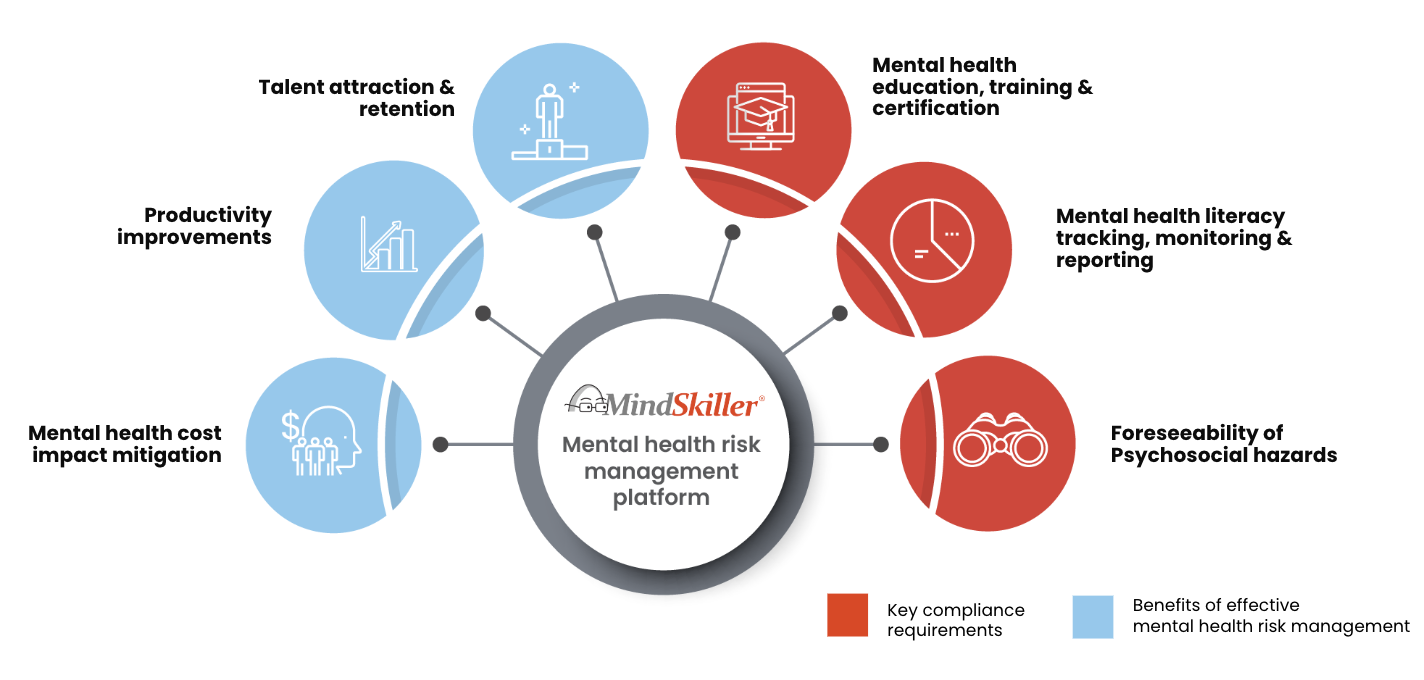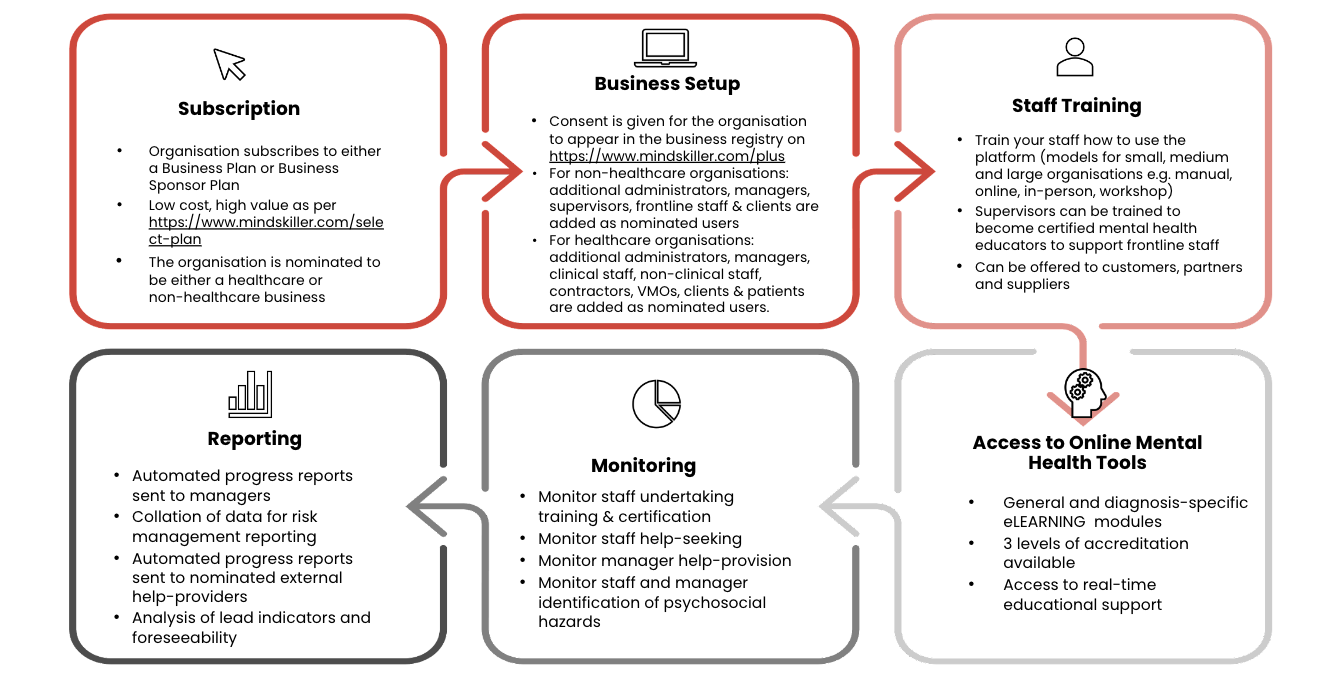The New OH&S Obligations: Programs and Tools to Help Organisations Comply (PART 2)
Employers' Duty of Care for the Mental Health of their Employees
Whether on a construction site or in an office, employers have a responsibility to provide a safe working environment for their employees. While this sentiment is widely accepted, preventing mental ill-health poses a greater challenge when compared to avoiding physical injuries.
As noted in the Productivity Commission's Inquiry into Mental Health (2020, p.300-301), it has become common for workplaces to appoint first aid officers, but "the equivalent 'mental first aid officer' in the workplace is rare." The lack of regulation around psychological safety had left many employees concerned whether their mental health issues would be considered legitimate by their employers (Productivity Commission, 2021, p.301; Hou & Chieng, 2022, p.976).
Safe Work Australia - the national statutory agency that develops policy to improve work health and safety (WHS) – has been working to address this gap. After an extensive review of the WHS model laws, Safe Work Australia has released a new model code of practice, offering guidance on managing psychosocial risks in the workplace. Through this, employers can bolster support for employee mental health and comply with legislation.
What are Psychosocial Hazards?
According to the model code of practice, psychosocial hazards are defined as factors that "can cause psychological and physical harm." Safe Work Australia provides an extensive list outlining situations that may qualify as psychosocial hazards, spanning from inadequate support and low job control to instances of bullying. While these instances may not cause immediate harm, psychosocial hazards often put employees in a stressful environment or state of mind. In a professional context, stress is "the body's reaction when a worker perceives the demands of their work exceed their ability or resources to cope…" (Safe Work Australia, 2022, p.6). This sort of elevated or prolonged stress is detrimental, prompting physiological and psychological reactions that can culminate in physical and mental ill-health (such as depression, anxiety or post-traumatic stress disorder).
Why are Psychosocial Hazards Significant for an Employer?
Research shows that job-related psychological injuries tend to have longer recovery times and require more time away from work (Smith et al., 2020). Therefore, employers who successfully address risks associated with psychosocial hazards limit disruptions caused by staff turnover, burnout and absenteeism. This, in turn, improves overall productivity and performance while ensuring compliance with existing legislation.
Since productivity is a concern across various industries, effectively addressing psychosocial hazards benefits all sectors of the workforce.
Healthcare workers, for instance, are experiencing a high level of job-related psychological distress in the wake of the COVID-19 pandemic - a result of being exposed to traumatic situations and having to work long hours.
"Burnout is clearly having a significant impact on this sector." Sam Nichols, Zoe Ferguson and Lisa Leong write for the ABC. "Last year, a study of almost 8,000 healthcare workers reported that one in 10 had thoughts of suicide or self-harm during the second wave of the COVID-19 pandemic."
Teachers have found themselves in a similar position. It has been widely reported that the shortage of teachers, coupled with pandemic-induced school closures, intensified burnout within the education sector. Meanwhile, other industries, ranging from hospitality to journalism, have seen employees grapple with hazardous workplace expectations and workloads.
Mental health conditions comprised "9.3 per cent of all serious workers compensation claims in 2020-21" (Trew et al., 2023). The percentage will likely increase in the coming years as legislative changes come into effect and more cases like Kozarov are brought to the courts. Given that these cases are "one of the most costly injuries to employers - including in terms of time off and compensation paid" (Trew et al., 2023), addressing psychosocial hazards should remain a priority for organisations and businesses.
Effectively Addressing Psychosocial Hazards in the Workplace
Discussions around meeting compliance requirements are often relegated to HR and Legal firms. However, all employers will need to become increasingly proactive in finding ways of addressing and minimising psychosocial hazards as legislation and regulations evolve. Psychosocial risks are omnipresent, requiring managers to implement effective control measures to avoid regulatory penalties, legal issues, and declining productivity. While it may seem like a formidable challenge, the model code of practice provides a comprehensive framework.

It initially falls to an employer to identify the potential workplace psychosocial hazards. In this context, employers must pinpoint various aspects within the workplace, roles, or situations that may pose harm to employees.
The employer must then assess the risks of the psychosocial hazards. Completing a risk assessment will help managers determine the severity of the hazards and what can be done to manage them. Through this process, an employer should identify the gravity of potential harm - considering the duration, frequency, and severity of an employee's exposure to a particular psychosocial hazard.
Next, employers must control the risk by identifying and selecting specific control measures. The primary objective is to eliminate the risk. However, if this is not feasible, the aim is to minimise it as much as possible. The model code of practice lists several potential control measures, including adjusting job demands to suit the worker and redesigning systems of work to ensure communication and support from supervisors.
The employer can then review the control measures to ensure they are effective. If that is not the case, they must be reviewed, modified, or replaced. Throughout it all, it is essential to record the risk management process and their outcomes.
Practical tools and Programs to Manage Psychosocial Hazards
Managers can implement a range of digital and in-person programs and tools to comply with the latest Safe Work Regulations, State Legislation and Common Law duties of care. Ensuring psychological health and safety at work doesn't have a one-size-fits-all solution. However, several practical tools are already available for managers to introduce in the workplace.
In-person Programs for Risk Management
Mental Health First Aid (MHFA) provides training and education to help individuals support others facing mental health challenges or crises. MHFA's Australian sector offers specialised courses for community-based organisations, workplaces, schools and tertiary institutions.
In a professional context, MHFA courses equip employees and employers with the skills and confidence necessary to respond to mental health challenges in the workplace. MHFA uses a "train-the-trainer model," where a national network of MHFA licensed instructors deliver courses to employees.
Workplaces can book publicly listed courses, arrange in-house training with licensed instructors, or train a staff member to become an instructor. This type of training proves particularly beneficial in the early stages of managing psychosocial hazards, helping employers identify and address these types of challenges.
Digital Tools for Risk Management
Foremind is an online platform that integrates counselling, compliance and content tailored for the workforce. It caters to the needs of both employees and employers, creating an environment where workers can report concerns and managers can take practical actions.
The platform allows workers to report psychosocial hazards and share wellness checks. Managers can efficiently identify stress-related factors and assess psychosocial hazards through these features. Foremind also provides a path forward by connecting employers with counsellors through video and telephone appointments.
By offering industry-specific mental health resources, Foremind also helps employers understand and address diverse challenges in the workplace. Managers can also track psychosocial hazards on the platform, identifying areas needing attention and improvement within the organisation.
Alternatively, MindSkiller® is a digital platform designed by mental health professionals. It embraces an education-first approach, hosting over 70 mental health education units and 3 training certificates. It also empowers managers to identify, assess and control psychosocial hazards in the workplace, as it is accompanied by monitoring and reporting capabilities for employers.
MindSkiller's eLEARNING modules cover general and diagnosis-specific content, providing both managers and employees with the knowledge to tackle different psychosocial hazards in the workplace. These modules are designed to be accessible, interactive and engaging, enabling individuals with varying backgrounds in mental health to benefit from MindSkiller® eLearning. Users can elevate their proficiency in mental health literacy by working through the three levels of accreditation.
With the opportunity for help-seekers to become help-providers, managers can become certified "mental health educators" and offer support to staff. There are also collaborative tools encouraging employees to keep their own external healthcare clinicians in the loop and help-seek when necessary.Ultimately, providing access to specialist-grade mental health education will upskill employees and mitigate the risks associated with psychosocial hazards - all while complying with the new WHS regulations, Common Law Duties of Care and State Legislation.

In addition, employers can use CONNECT - MindSkiller's real-time education feature integrating video-conferencing support with eLearning - to touch base with staff and monitor their psychological well-being. Regular conversations and check-ins provide employers with valuable insights into potential psychosocial hazards at work, informing the implementation of control measures.
In addition to these sorts of conversations, the MindSkiller® platform streamlines monitoring and tracking through reports and user data. Through automated progress reports, employers can easily communicate their course progress to managers and designated external support providers. Once at-risk employees are identified, they can complete a MindSkiller-provided questionnaire to help employers manage the relevant psychosocial hazards.
On a broader scale, managers are guided by MindSkiller’s "Clinical Care Pathway." This form was created per the Model Code of Practice, providing a checklist that helps employers evaluate how organisational business units use the platform to address the risk of workplace psychosocial hazards. De-identified user data and analytics collated by MindSkiller® also offer a high-level analysis of the workplace, assisting the management team to foresee areas where psychosocial hazards pose a significant risk.

Sources:
https://www.safeworkaustralia.gov.au/system/files/documents/1902/review_of_the_model_whs_laws_final_report_0.pdf
https://www.holdingredlich.com/nsw-government-bulletin-managing-psychosocial-hazards-in-the-workplace
https://www.holdingredlich.com/elevating-the-duty-to-ensure-psychosocial-safety-new-law-and-key-compliance-considerations-part-1#
https://www.abc.net.au/news/2023-04-21/how-psychosocial-workplace-hazards-can-impact-mental-health/102224278
https://www.asuvictas.com.au/wp-content/uploads/2023/09/20230905-Low-Job-Control.pdf
https://www.safeworkaustralia.gov.au/sites/default/files/2022-08/model_code_of_practice_-_managing_psychosocial_hazards_at_work_25082022_0.pdf
https://link.springer.com/article/10.1007/s00127-020-01839-3